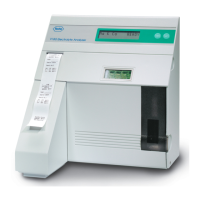Roche Diagnostics
Instructions for Use · Version 10.0 101
9180 Electrolyte Analyzer 7 Measurement
Preanalytics
Sample handling
When measuring calcium values, make sure that the sample is not exposed to
ambient air. Incorrect calcium values will occur if the sample is exposed to ambient
air. Contact with ambient air results in a loss of CO
2
in the sample. As a result, pH
values rise in the sample and calcium values are reduced.
Whole blood
Withdraw whole blood samples using heparinized syringes or capillaries and analyze
the samples as soon as possible after sampling. Remove air bubbles from the sample
collection container immediately after the sampling procedure.
CAUTION
Air bubbles may lead to incorrect results
Air bubbles in samples deteriorate electrode performance and the integrity of patient
samples, which may lead to incorrect patient results. In addition, it may lead to a loss of
sample.
r Remove all air bubbles from sample collection containers immediately after collecting
samples.
Immediately after withdrawing the sample with syringes, thoroughly mix the sample
with anticoagulant. This can be done by rolling the sample between both hands and
inverting. Label samples according to standard documentation procedures.
o Samples that are measured within 15 minutes may be retained at room
temperature (20 - 25 °C).
o If you are unable to measure samples within 15 minutes, place them temporarily
in ice water. Complete the measurement within 30 minutes (but not after more
than 60 minutes).
Despite proper sampling procedures, errors can arise in the analysis due to:
o insufficient mixing of the sample after sampling and before the measurement
o ambient air contamination caused by air bubbles that are not removed after
sampling
o changes in metabolism in the sample
Serum
After the appearance of spontaneous clotting, centrifuge the sample to separate the
cellular and solid components, and the fibrin from the watery serum. Transfer the
serum to a suitable sample container and seal.
If it is necessary to store the sample, close the sample container tightly and cool it to
4 - 8 °C. If a sample has been cooled, warm it to room temperature (20 - 25 °C) before
analysis.
Plasma
Plasma samples are obtained by centrifuging heparinized whole blood, during which
the cellular components of the blood are removed from plasma.
Complete the analysis as quickly as possible.
If it is necessary to store the sample, close the sample container tightly and cool it to
4 - 8 °C. If a sample has been cooled, warm it to room temperature (20 - 25 °C) before
analysis.

